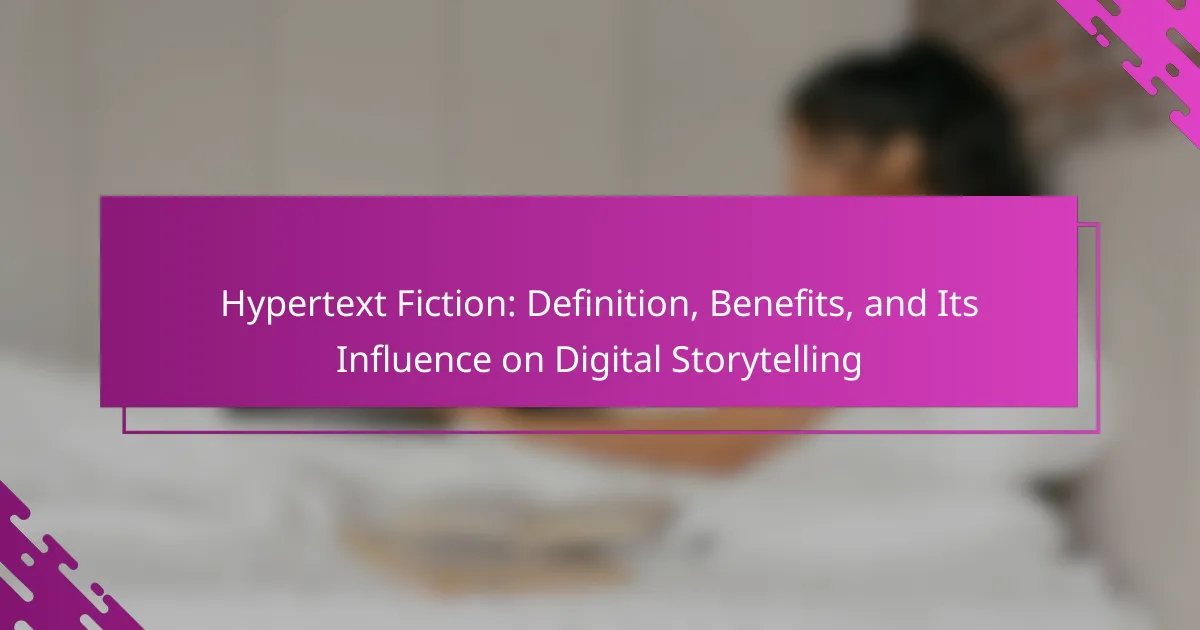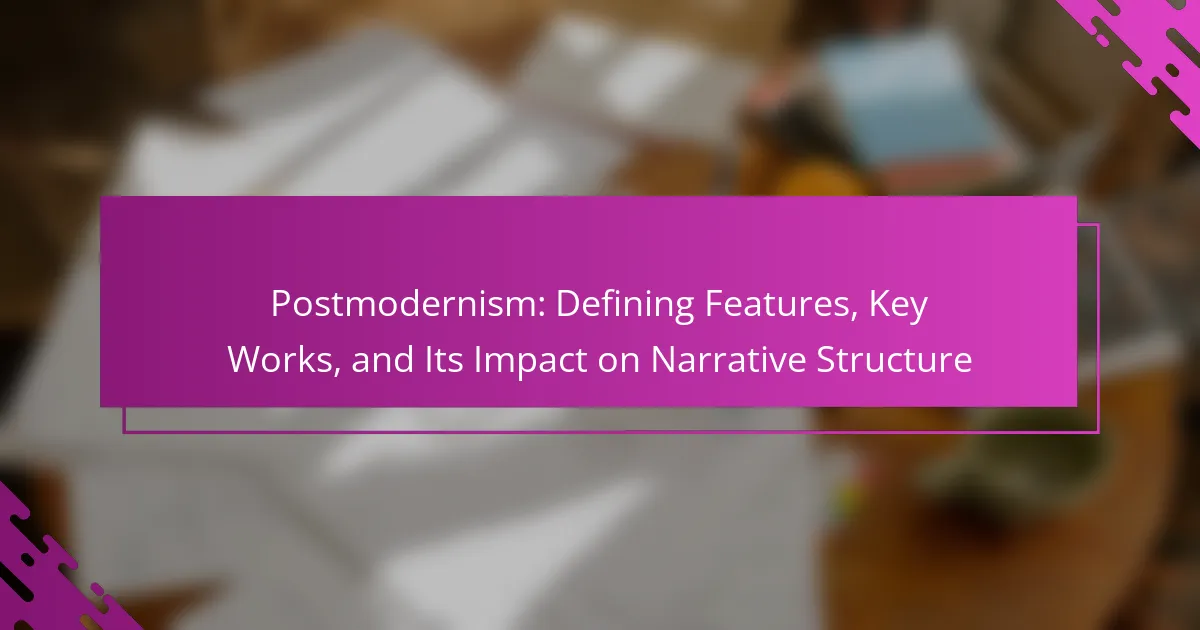Flash fiction offers a unique way for writers to convey powerful narratives in a concise format. This article explores its definition, highlights the benefits for writers, and examines its evolving role in modern storytelling. Key platforms for publishing flash fiction are discussed, alongside cultural influences and emerging trends shaping the genre. The challenges writers face in crafting impactful stories within strict word limits are also addressed.
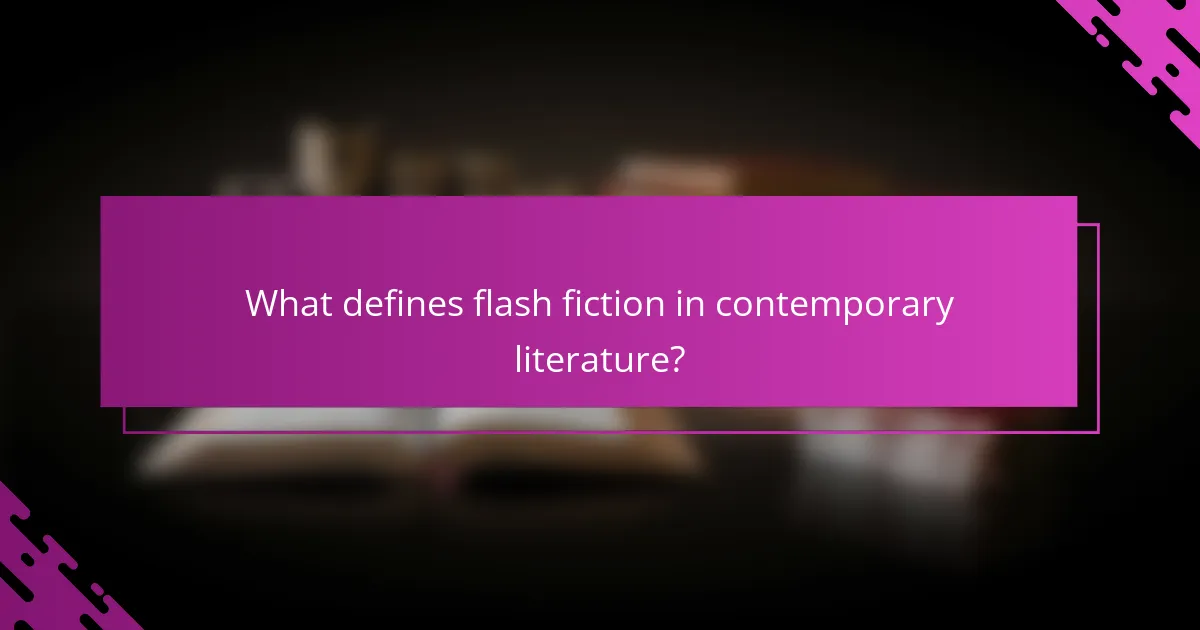
What defines flash fiction in contemporary literature?
Flash fiction is defined as a brief narrative that typically ranges from 100 to 1,000 words. It emphasizes concise storytelling, allowing authors to explore themes and emotions quickly. This format benefits writers by honing their skills in brevity and precision, making it valuable in contemporary literature. Flash fiction occupies a unique place in modern storytelling, appealing to audiences with limited time and a desire for impactful narratives. Its root attribute is brevity, while its unique attribute is the ability to evoke strong emotions in a compact form.
How does flash fiction differ from traditional short stories?
Flash fiction is typically shorter and more focused than traditional short stories. It often conveys a complete narrative within a few hundred words, emphasizing brevity and impact. Traditional short stories usually allow for more character development and plot complexity. Flash fiction thrives on suggestion and implication, often leaving much to the reader’s imagination. This unique attribute of conciseness enables flash fiction to deliver powerful emotions and themes in a limited space, making it a popular choice in modern storytelling.
What are the common characteristics of flash fiction?
Flash fiction is characterized by brevity, typically under 1,000 words, and focuses on a single moment or idea. Its common traits include concise storytelling, limited character development, and a strong emotional impact. The form often employs suggestive language, leaving much to the reader’s imagination. Flash fiction’s unique attribute is its ability to convey complex themes in a compact format, making it a popular choice in modern storytelling.

What are the key benefits of writing flash fiction?
Writing flash fiction enhances creativity, encourages brevity, and hones storytelling skills. It allows writers to convey powerful emotions and ideas within a limited word count, making every word count. The unique attribute of flash fiction is its ability to create impactful narratives quickly, appealing to modern readers’ preferences for concise content. Additionally, flash fiction fosters experimentation with narrative styles and structures, offering writers a platform for innovation in storytelling.
How does flash fiction enhance creativity and brevity?
Flash fiction enhances creativity and brevity by challenging writers to convey powerful narratives in limited word counts. This form of storytelling encourages concise expression, forcing authors to focus on core ideas and emotions. As a result, it fosters innovative thinking and unique storytelling techniques. The brevity of flash fiction also appeals to modern audiences, who often prefer quick, engaging content. By honing these skills, writers can improve their overall craft and adaptability in various writing formats.
What role does flash fiction play in engaging modern readers?
Flash fiction captivates modern readers by delivering concise narratives that fit busy lifestyles. Its brevity allows for quick engagement, making it ideal for digital platforms. Flash fiction often explores unique themes, sparking imagination in limited word counts. This format encourages experimentation and innovation, appealing to diverse audiences. As a result, it plays a crucial role in contemporary storytelling by fostering creativity and accessibility.
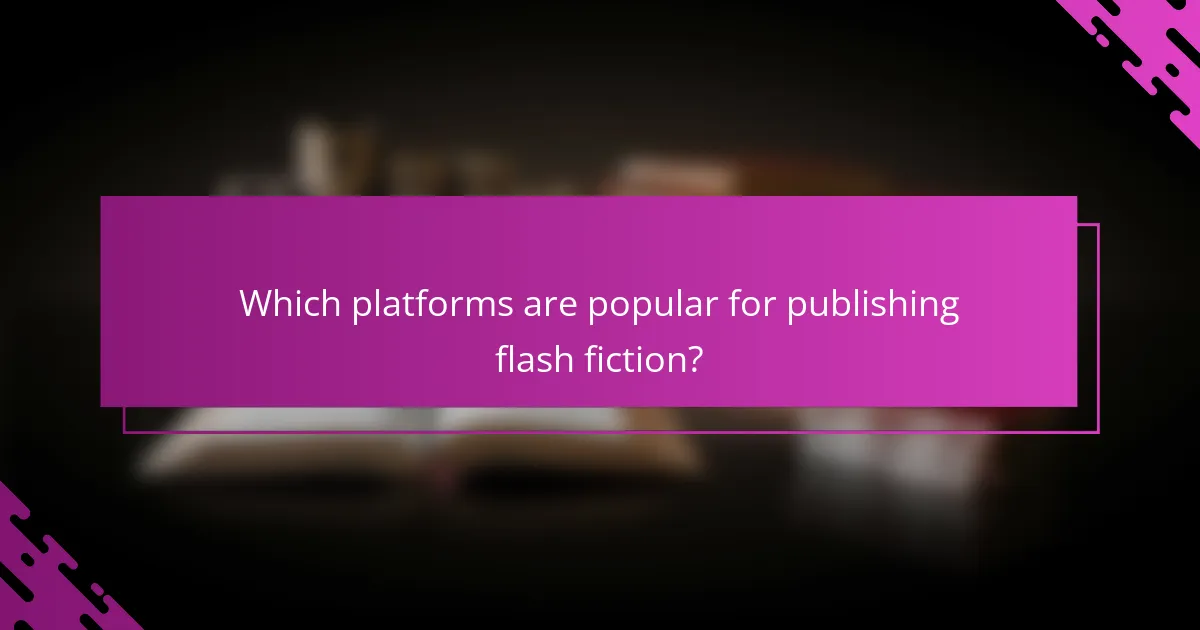
Which platforms are popular for publishing flash fiction?
Popular platforms for publishing flash fiction include Wattpad, Medium, and Submittable. These platforms offer writers a space to share their work and connect with readers. Wattpad caters to a younger audience, while Medium attracts professionals and enthusiasts. Submittable focuses on submission management for literary magazines and contests, providing a formal route for publication. Each platform supports diverse genres and styles, enhancing the visibility of flash fiction in modern storytelling.
How do online literary magazines contribute to flash fiction’s popularity?
Online literary magazines significantly enhance flash fiction’s popularity by providing accessible platforms for emerging writers. They showcase diverse voices, fostering community engagement and reader interest. Additionally, these magazines often feature contests and themed issues, motivating writers to create and submit their work. This exposure helps establish flash fiction as a respected form of modern storytelling, appealing to audiences seeking quick yet impactful narratives.
What social media channels are effective for sharing flash fiction?
Social media channels effective for sharing flash fiction include Twitter, Instagram, and Facebook. These platforms support concise storytelling and visual engagement, appealing to audiences seeking quick reads.
Twitter’s character limit encourages brevity, making it ideal for flash fiction. Instagram allows for visual storytelling, enhancing narrative through images. Facebook’s community features facilitate sharing and discussions, fostering reader engagement.
Each channel has unique attributes that cater to different aspects of flash fiction, enhancing its reach and impact in modern storytelling.
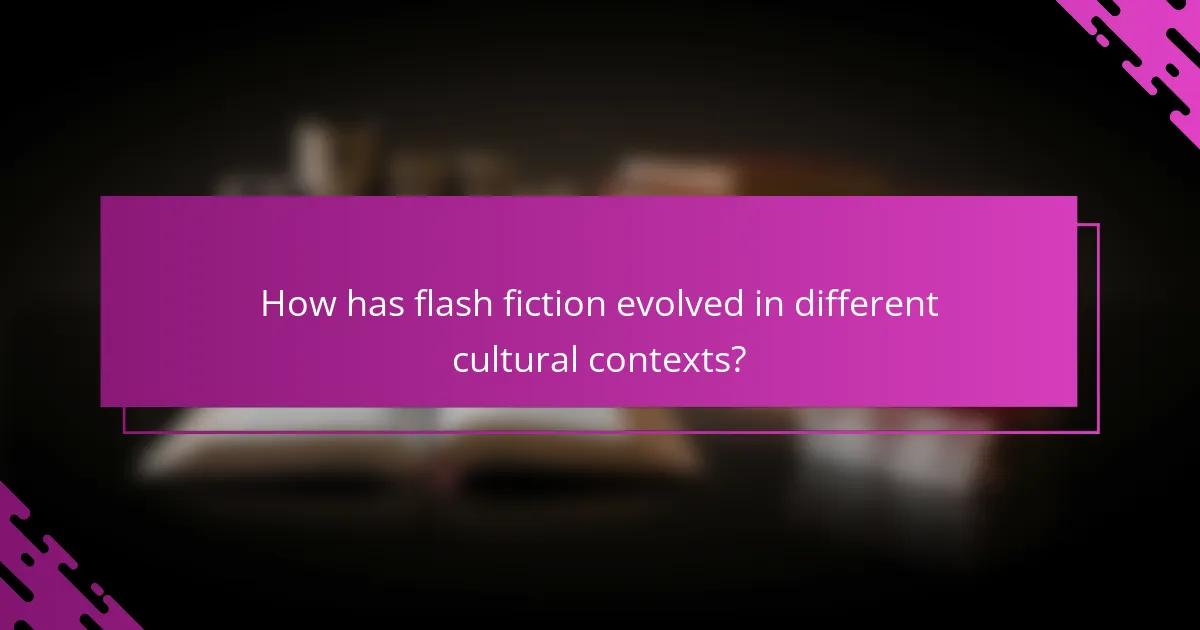
How has flash fiction evolved in different cultural contexts?
Flash fiction has evolved significantly across various cultural contexts, reflecting local storytelling traditions and societal values. In Japan, for instance, the art of “haiku” has influenced flash fiction, emphasizing brevity and depth. In contrast, Latin American writers often blend vivid imagery with social commentary, showcasing cultural narratives in concise formats.
The accessibility of digital platforms has further transformed flash fiction, allowing diverse voices to emerge globally. As a result, it serves as a powerful medium for cultural exchange and experimentation, adapting to the unique characteristics of different literary traditions. This evolution highlights flash fiction’s role in modern storytelling, bridging cultural gaps while maintaining its core essence of brevity and impact.
What unique storytelling techniques are used in flash fiction across cultures?
Flash fiction employs unique storytelling techniques that vary across cultures, emphasizing brevity and impact. Techniques include the use of symbolism, non-linear narratives, and cultural references, which allow for rich, layered meanings in limited word counts. For instance, in Japanese flash fiction, known as “shintaishi,” the focus on nature and emotion creates a distinct aesthetic. In contrast, Latin American flash fiction often incorporates magical realism, blending the ordinary with the extraordinary. These techniques highlight the cultural context while maintaining the essence of flash fiction’s concise form.
How do regional themes influence flash fiction narratives?
Regional themes significantly shape flash fiction narratives by infusing them with local culture, language, and societal issues. These elements create authenticity and resonate with readers, enhancing emotional engagement. For instance, a narrative set in a specific region may reflect its traditions, dialects, and challenges, making the story more relatable. Additionally, regional themes can influence character development and plot structure, as they often draw from local histories and contemporary contexts. This connection to place enriches the storytelling experience, allowing writers to explore universal themes through a localized lens.
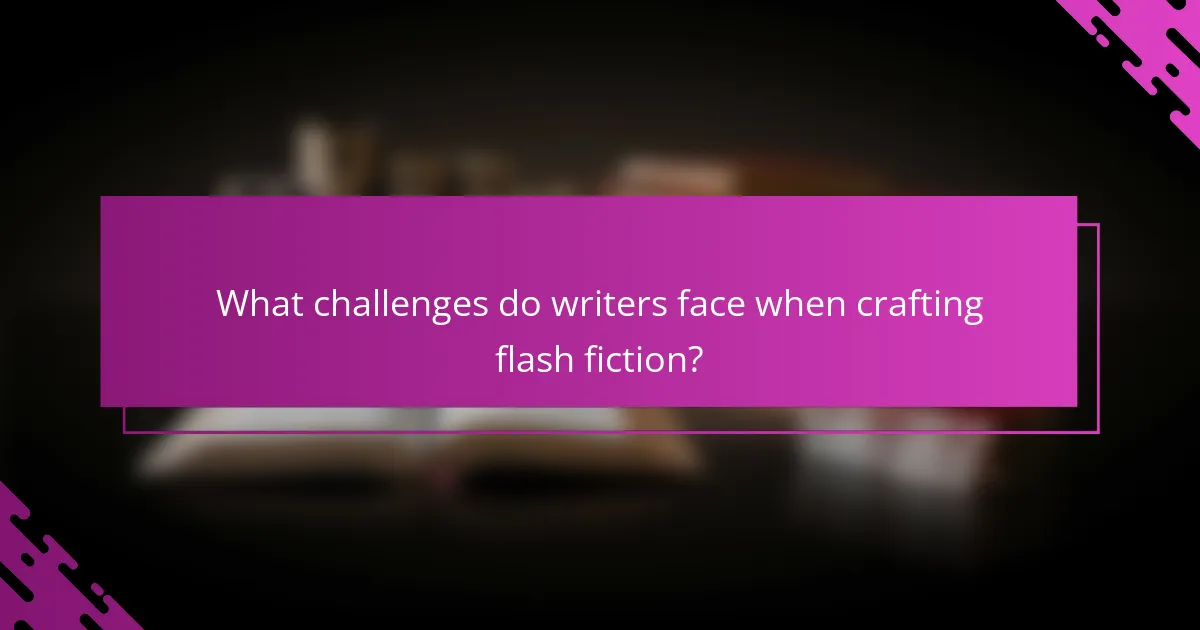
What challenges do writers face when crafting flash fiction?
Writers face several challenges when crafting flash fiction, including brevity, character development, and plot compression. The limited word count requires precise language and focused storytelling. Creating relatable characters in a short format can be difficult, as there is little space for backstory. Additionally, maintaining a coherent plot while delivering a satisfying narrative arc can be challenging. These constraints push writers to be innovative and concise, often leading to unique storytelling techniques.
How can writers overcome common pitfalls in flash fiction?
Writers can overcome common pitfalls in flash fiction by focusing on brevity, clarity, and strong character development. Prioritize essential elements and eliminate unnecessary details to maintain impact. Use vivid imagery and precise language to convey emotions and settings effectively. Additionally, ensure a compelling conflict and resolution, even within limited word counts, to engage readers.
What strategies can enhance the impact of flash fiction?
To enhance the impact of flash fiction, focus on brevity, strong imagery, and emotional resonance. Utilize concise language to convey powerful themes within limited word count.
Incorporate a twist or unexpected ending to leave a lasting impression. Engage readers by creating relatable characters and situations, even in a short format. Use vivid descriptions to evoke strong imagery, allowing readers to visualize the story.
Experiment with narrative structure, such as starting in the middle of the action or using non-linear timelines to create intrigue. Prioritize strong openings that grab attention immediately, as the first few sentences are crucial for engagement.
Lastly, revise rigorously to eliminate unnecessary words, ensuring every sentence contributes to the overall impact.
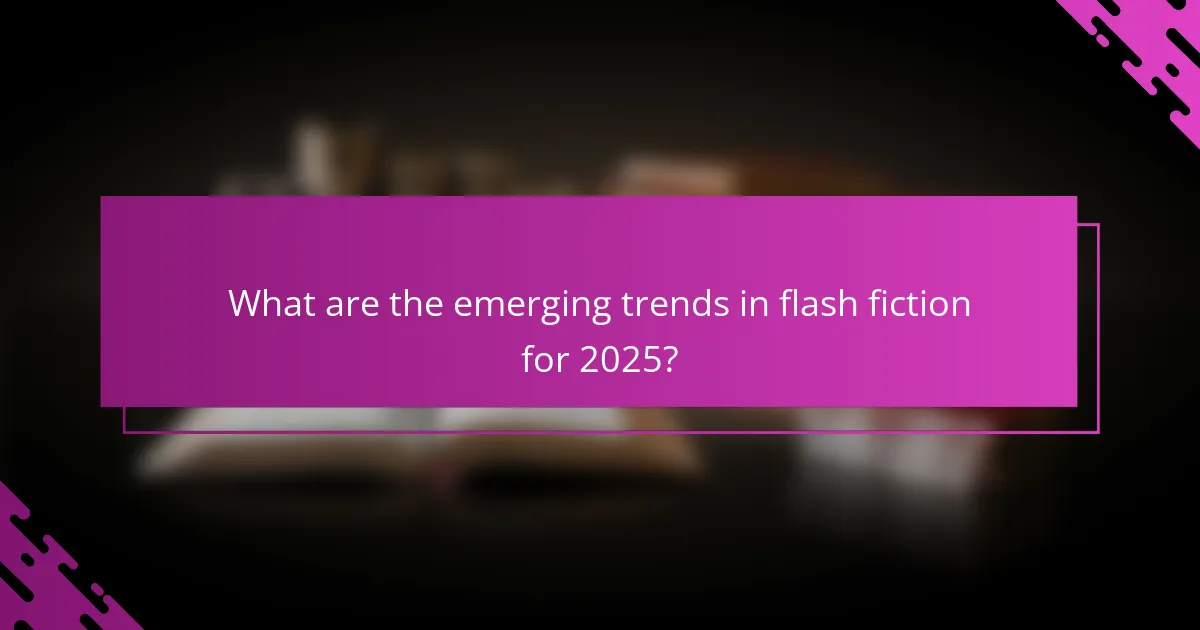
What are the emerging trends in flash fiction for 2025?
Emerging trends in flash fiction for 2025 include increased digital integration, interactive storytelling, and a focus on diverse voices. Writers are leveraging social media platforms for wider reach and engagement. As a result, flash fiction is evolving to reflect contemporary issues and resonate with varied audiences. The rise of AI tools is also shaping narrative styles, offering new ways to craft concise stories.
How is technology shaping the future of flash fiction?
Technology is revolutionizing flash fiction by enhancing accessibility and engagement. Digital platforms enable writers to reach wider audiences instantly. Interactive storytelling tools allow for innovative narrative forms, blending text with multimedia elements. Additionally, social media fosters community feedback, shaping stories in real-time. These advancements empower diverse voices, making flash fiction more inclusive and dynamic in modern storytelling.
What role does reader feedback play in the evolution of flash fiction?
Reader feedback significantly shapes the evolution of flash fiction by guiding writers in refining their narratives. This interaction fosters a responsive writing process, enabling authors to adapt themes, styles, and structures based on audience preferences. Feedback highlights what resonates emotionally, allowing for deeper character development and more engaging plots. Additionally, it encourages experimentation with brevity, as writers learn to convey powerful messages within limited word counts. Ultimately, reader insights contribute to the dynamic nature of flash fiction, ensuring it remains relevant in modern storytelling.
What best practices can improve flash fiction writing?
To improve flash fiction writing, focus on clarity, brevity, and emotional impact. Start with a strong hook to engage readers immediately. Use concise language to convey your story efficiently, ensuring each word serves a purpose. Develop well-defined characters and settings quickly to create a vivid image in the reader’s mind. Emphasize a single theme or emotion to maintain focus and resonance. Finally, revise rigorously to eliminate unnecessary details, enhancing the overall impact of your narrative.
